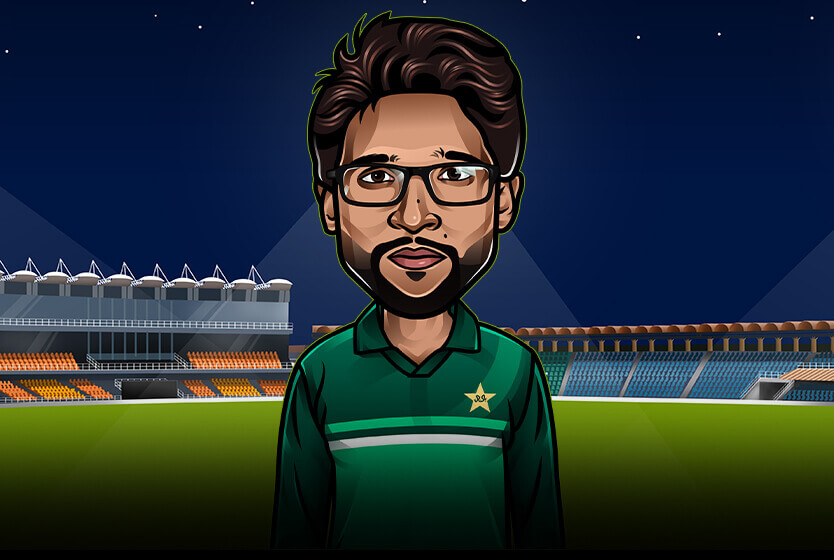
Imam-ul-Haq, Rejuvenation, and Appreciation
The quest to struggle through adversity and become a good cricketer often goes unappreciated. Usually, that’s because there’s someone else around who is far more naturally gifted with a higher ceiling. After all, generational cricketers are superstars, and these personalities are understandably the ones vociferously backed in the age of social media, even when they falter. But that’s not a luxury often awarded to the lesser players on a team – applicable to any team sport. When those lesser players achieve something significant, their achievements may be overlooked.
A modern-day top ODI opener averages 40+ at a strike rate of 90+. In fact, the average opener for a top 10 ODI side has churned out runs @ 40/90 since 2015. Now Imam-ul-Haq has always known how to score runs. Perhaps it’s in the genes, with him being inspired by his uncle’s exploits. So fulfilling the former part of the equation was hardly going to be a challenge. But the latter is worth discussing and scrutinizing, particularly in the context of being a Pakistani batsman (and opener to boot).
In Under-19 (Youth) ODIs, Imam is one of only five Pakistan batsmen to make more than 1000 runs (1106 @ 43/67 avg/SR). But of the 16 Pakistani batsmen to have made more than 500 runs, his strike rate is the fourth-lowest. Of the 30 batsmen in Youth ODI history to breach 1000 runs, his strike rate is the fourth-lowest. The same trend continued in the List A format as he transitioned to domestic cricket, albeit with a slightly higher SR. Before his ODI debut, he had almost 1100 runs to his name at 44/76.
Fast forward a bit – Imam scores a hundred on his ODI debut and becomes an important component of the ODI side, soon usurping Ahmed Shehzad and Azhar Ali. However, concerns about the scoring rate are quick to take center stage – concerns additional to the parchi chants that have followed him throughout the course of his career due to his famous uncle. These are only going to get louder, with his fellow opening batter being Pakistan’s first real modern-day ODI opener while Babar Azam begins to gun for the Number 1 ODI batsman crown.
This is where it becomes important to contextualize Imam’s early performances during his career. Fine, his career strike rate was 67 in Youth ODIs. But what were other batters around him doing? As it transpires, he was about par. Pakistan’s top 3 batters in Under-19 ODIs involving Imam-ul-Haq had a strike rate of 70. If we account for the top 3 batters from both sides in matches involving him, the strike rate is roughly 68. What, then, about domestic cricket? In the 26 List A matches Imam played before his ODI debut, batsmen in the top 3 struck at 80, as opposed to Imam’s 76. Again, just below par. Players tend to adapt to the mentality around them, and if that is one that focuses on conservative batting from the top-order, then so be it. England’s opposite approach has seen much of their limited-overs prospects evolve their batting according to a certain style that is almost a demand in their white-ball setup.
International cricket is a pretty big step-up from most forms of domestic cricket, particularly List A cricket – even more so nowadays when the Pakistan Cup is the most neglected part of the domestic season (rightfully so, it can be argued). Thus, a batsman struggling at the highest level while transitioning shouldn’t be taken as an ultimate indicator of his quality. Imam, nevertheless, found run-scoring easy, piling up runs with ease against Sri Lanka, Zimbabwe, South Africa, England, and in the Asia Cup. But the rate of run-scoring remained a problem.
Before 2022, Imam played 46 ODIs with 2000+ runs @ 49/80. However, in matches involving Imam, Pakistan and the opposition’s top 3 both scored runs at a strike rate of 88, with Fakhar Zaman and Babar Azam both scoring @ 90+. This meant that the left-hander’s strike rate became a constant point of scrutiny and discussion, despite his consistent run-scoring. So what were the underlying reasons behind these struggles?
A regular ODI opener’s innings can be broken down into three general phases: powerplay, consolidation, and tee-off. The first two are of the greatest importance for the most part, with the last one usually coming into play if the opener scores a big ton and beyond, heading toward the death overs.
The powerplay phase is interesting because there are a few different valid approaches, unlike T20 cricket, where having at least one aggressor is a must. In ODIs, Jason Roy and Jonny Bairstow follow the England template of scoring fast throughout the innings, while David Warner also tends to score at a good clip. The likes of Quinton de Kock, Shikhar Dhawan, Martin Guptill, Fakhar Zaman, and Aaron Finch are slightly more sedate on average, striking @ 80-90. Then, there are the plodders: the likes of Rohit Sharma, Tamim Iqbal, Shai Hope, and Imam-ul-Haq, striking @ around 65-75.
The consolidation phase starts after the powerplay. For openers, this is a chance to start upping the ante. If you get through the powerplay, you’ve faced 25-35 balls and are fairly well-settled at the crease. Opposition teams usually spread the field, and there are plenty of scoring opportunities. At this point, you need to be able to counter the spinners on offer, alongside the other change bowlers that the opposition will employ. Most top openers have a fairly strong record in this period but with a few key differences that we’ll get to later.
2022 has seen a turnaround in Imam-ul-Haq’s overall ODI output. He is now above par, with top 3 batters in matches involving Imam this year striking at around 95. And he has done it in style, with focus on bolstering a few areas of concern.
| 2017-21 | Overall | 2022 |
| 46 | Inns | 6 |
| 2023 | Runs | 497 |
| 49 | Avg | 99 |
| 80 | SR | 99 |
| 7 | 100s | 2 |
| 10 | 50s | 4 |
| 50 | Dot % | 40 |
| 14.1 | BpB | 11.2 |
Imam is never going to be a Bairstow, Roy, or Warner. But he doesn’t have to strike at 65 in the powerplay. There is a middle ground, and that middle ground is what he has achieved recently with momentous improvement. He did this with significantly better strike rotation and a slight improvement in boundary-hitting as well. Most teams besides England aren’t focused on going too hard in the powerplay, and they’re fine with concentrating a bit more on wicket conservation alongside a reduced rate of scoring. Thus, 50/0 after 10 overs can be considered a good start in most conditions, and that requires a powerplay strike rate of 80-85. One or two set high-quality openers after 10 overs offer a considerable upside.
| 2017-21 | Powerplay | 2022 |
| 47 | Avg | – |
| 66 | SR | 86 |
| 67.2 | Dot % | 57.4 |
| 11.5 | BpB | 9.0 |
The real improvement that we’ve witnessed in Imam’s game, though, is not in the powerplay. After all, the initial phase is only 10 overs, and there’s only so much you can do in that phase. But maximizing the consolidation phase is what almost all of the best ODI openers manage nowadays. The key to that is being positive against the change bowlers, rotating the strike well, and finding the boundaries occasionally – particularly against spinners. And that’s where Imam’s game has risen to the next level.
| 2017-21 | 11-40 vs. Spin | 2022 |
| 46 | Avg | 64 |
| 79 | SR | 111 |
| 42.2 | Dot % | 32.8 |
| 28.7 | BpB | 10.5 |
Imam-ul-Haq’s best friend also happens to be the best batsman in the world. It’s only natural that he’d pick up a few things from him. He said as much after the conclusion of the West Indies series, stating that the two mulled over how they could be more proactive and look to transfer the pressure onto the bowling side more often. While Imam has always been a fairly good player of spin, he perhaps wasn’t proactive enough in the past. Now, he’s batting like a modern-day opener who actually takes on the spinners once set. Left-handed openers particularly maintain a slight advantage in this regard, with most spinners nowadays being left-arm orthodox or leggies.
With more decisive footwork (very similar to how Babar plays spin himself), including using the depth of the crease and coming down the track, Imam has found immense success, with his aggressive approach also helping to put bowlers off their lengths. Moreover, this has a far-reaching impact on Pakistan’s ODI batting composition. With all three of Fakhar, Imam, and to an extent Babar comfortable with scoring freely against spin, the team can afford to accommodate Mohammad Rizwan at number 4, usually not the most free-flowing batsman against the slower bowlers, particularly starting off. And while it won’t happen, Imam’s skillset means he might even be able to bat at number 4, if required.
The usual caveats apply. The sample size is currently relatively small. But it’s a start. All these 6 ODIs were played at home in familiar conditions and against middling bowling attacks. But Imam has played 50-over cricket in Pakistan before, and he has faced middling attacks before. And he never managed this level of output in the 50-over format. Anyway, ODIs are hardly the same as Test cricket, and conditions play a slightly limited role. It’s more about understanding your game and knowing the moments where you need to take the initiative. Most importantly, having the experience of playing a particular brand of cricket will hold you in good stead in the crunch moments. With an unbroken sequence of 7 scores of 50+ in ODIs, Imam-ul-Haq is now galloping toward Javed Miandad’s record of 9.
Imam-ul-Haq is never going to be the most eye-catching or most spectacular batsman. But he has quietly worked on his game and jumped to number 2 in the ICC ODI Batting Rankings. And that has come with a lot of hard work on his skills, mentality, and fitness. After the West Indies series, he alluded to the hard work done by all of the Pakistani cricketers, emphasizing that he himself had lost 5-6 kilos. This is where the tiny margins come into play, and even the barest of margins can be enough to win a World Cup. Pakistan cricket is more used to seeing players fizzle out after bright starts, not go from strength to strength with mid-career improvements. But this team is different, and all the players have a desire to sincerely keep learning and improving. And rejuvenation really does deserve appreciation.







Leave a Reply